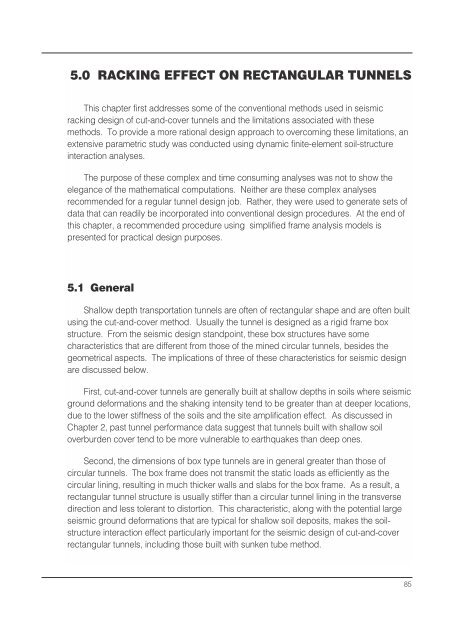Seismic Design of Tunnels - Parsons Brinckerhoff
Seismic Design of Tunnels - Parsons Brinckerhoff
Seismic Design of Tunnels - Parsons Brinckerhoff
Create successful ePaper yourself
Turn your PDF publications into a flip-book with our unique Google optimized e-Paper software.
5.0 RACKING EFFECT ON RECTANGULAR TUNNELS<br />
This chapter first addresses some <strong>of</strong> the conventional methods used in seismic<br />
racking design <strong>of</strong> cut-and-cover tunnels and the limitations associated with these<br />
methods. To provide a more rational design approach to overcoming these limitations, an<br />
extensive parametric study was conducted using dynamic finite-element soil-structure<br />
interaction analyses.<br />
The purpose <strong>of</strong> these complex and time consuming analyses was not to show the<br />
elegance <strong>of</strong> the mathematical computations. Neither are these complex analyses<br />
recommended for a regular tunnel design job. Rather, they were used to generate sets <strong>of</strong><br />
data that can readily be incorporated into conventional design procedures. At the end <strong>of</strong><br />
this chapter, a recommended procedure using simplified frame analysis models is<br />
presented for practical design purposes.<br />
5.1 General<br />
Shallow depth transportation tunnels are <strong>of</strong>ten <strong>of</strong> rectangular shape and are <strong>of</strong>ten built<br />
using the cut-and-cover method. Usually the tunnel is designed as a rigid frame box<br />
structure. From the seismic design standpoint, these box structures have some<br />
characteristics that are different from those <strong>of</strong> the mined circular tunnels, besides the<br />
geometrical aspects. The implications <strong>of</strong> three <strong>of</strong> these characteristics for seismic design<br />
are discussed below.<br />
First, cut-and-cover tunnels are generally built at shallow depths in soils where seismic<br />
ground deformations and the shaking intensity tend to be greater than at deeper locations,<br />
due to the lower stiffness <strong>of</strong> the soils and the site amplification effect. As discussed in<br />
Chapter 2, past tunnel performance data suggest that tunnels built with shallow soil<br />
overburden cover tend to be more vulnerable to earthquakes than deep ones.<br />
Second, the dimensions <strong>of</strong> box type tunnels are in general greater than those <strong>of</strong><br />
circular tunnels. The box frame does not transmit the static loads as efficiently as the<br />
circular lining, resulting in much thicker walls and slabs for the box frame. As a result, a<br />
rectangular tunnel structure is usually stiffer than a circular tunnel lining in the transverse<br />
direction and less tolerant to distortion. This characteristic, along with the potential large<br />
seismic ground deformations that are typical for shallow soil deposits, makes the soilstructure<br />
interaction effect particularly important for the seismic design <strong>of</strong> cut-and-cover<br />
rectangular tunnels, including those built with sunken tube method.<br />
85
















